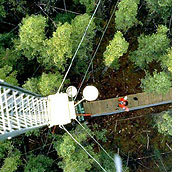

 | |||
| It’s early summer 1994, 12:34 p.m. local time, and the
Canadian Twin Otter research aircraft is flying 20 meters (about 65
feet) above the boreal forest canopy near Prince Albert, Saskatchewan.
Scientists are busy measuring the exchanges of gas and heat between the
forest and the lower atmosphere when the plane flies into an unseen
vortex of intense, heat-induced winds—a "dust devil," as these phenomena
are called in desert regions of the southwestern United States.
Instruments aboard the aircraft clock the wind shift across the wall of
the vortex at nearly 20 meters per second (45 miles per hour) and the
updraft at the center of the vortex at 11 meters per second (25 miles
per hour). Without warning, the strong winds catapult the Twin Otter
upward and sideways in a few seconds. Fortunately, the pilot is able to
stabilize the aircraft and return the plane and crewmembers safely to
the ground, albeit a little shaken up. That summer the Twin Otter flew
into eight such vortices in four months (MacPherson and Betts, 1997).
|
by David Herring June 11, 1999 Boreal Ecosystem Series
| ||
 As an integral part
of NASA’s Boreal Ecosystem-Atmosphere Study (BOREAS)
measurement strategy, a team of researchers, including Alan K. Betts from
Vermont, used instruments aboard the Twin Otter and on forest towers to
measure interactions between the forest and the lower atmosphere. During
each season from 1994—97, data were collected on the
exchanges of heat, momentum, carbon dioxide, ozone and water vapor to
gain insights into the ongoing "dialogue" that occurs between the boreal
ecosystem and the atmosphere. Their goal is to understand how changes
in air temperature, moisture and carbon dioxide levels may impact the
boreal ecosystem and what role the boreal forest plays in global-scale
climate changes. As an integral part
of NASA’s Boreal Ecosystem-Atmosphere Study (BOREAS)
measurement strategy, a team of researchers, including Alan K. Betts from
Vermont, used instruments aboard the Twin Otter and on forest towers to
measure interactions between the forest and the lower atmosphere. During
each season from 1994—97, data were collected on the
exchanges of heat, momentum, carbon dioxide, ozone and water vapor to
gain insights into the ongoing "dialogue" that occurs between the boreal
ecosystem and the atmosphere. Their goal is to understand how changes
in air temperature, moisture and carbon dioxide levels may impact the
boreal ecosystem and what role the boreal forest plays in global-scale
climate changes.
One of Betts’ primary research objectives was to quantify the amount of heat emitted and light reflected by the boreal forest. The vortices of hot air that occasionally sent his colleagues on the Twin Otter "thrill rides" reinforced what other measurements were showing—the boreal forest stores and releases significantly more heat to the atmosphere in the spring and early summer than scientists previously thought.
The data used in this study are available in one or more of NASA's Earth Science Data Centers. |
The boreal forest canopy as seen from the top of a tower about 30 meters above the ground. To measure the fluxes of heat and gases exchanged between the forest ecosystem and the lower atmosphere, the BOREAS team mounted sensitive instruments on these towers at multiple sites in the Canadian boreal forest. Measurements from these flux towers were complimented by measurements made aboard the Twin Otter research aircraft flying at roughly this altitude. (Photograph courtesy BOREAS project) | ||